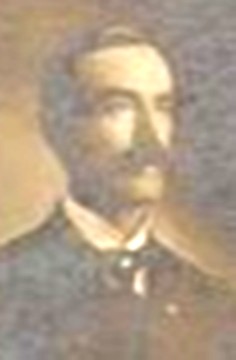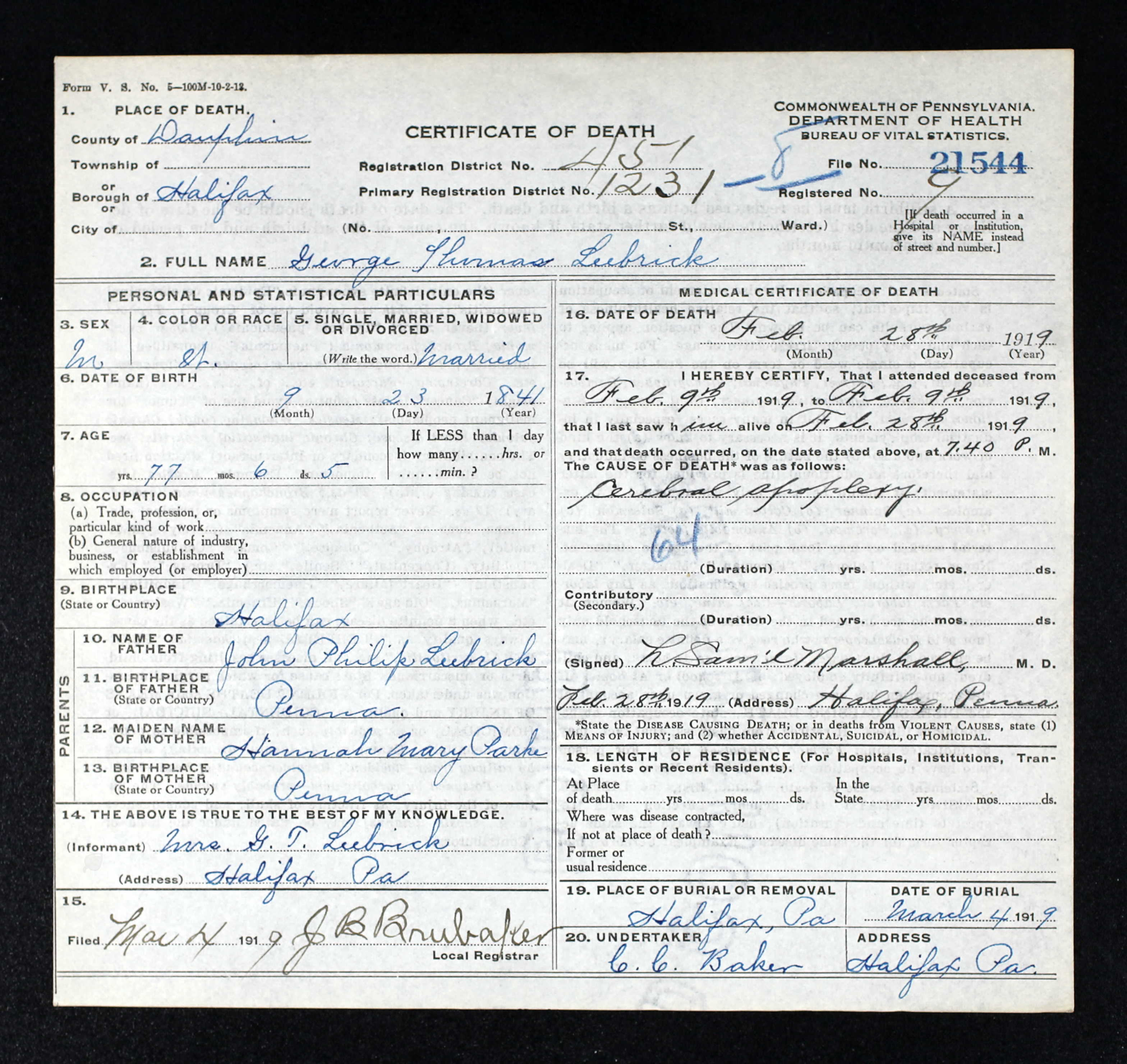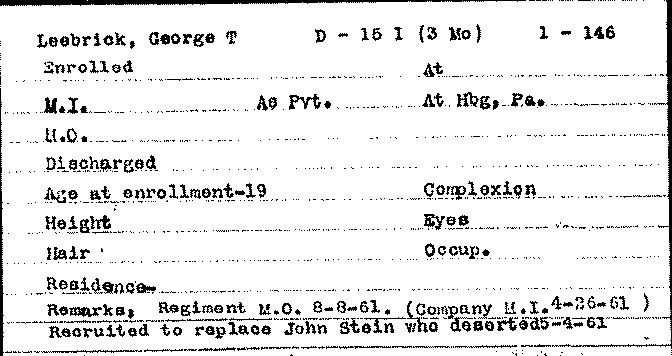Posted By Norman Gasbarro on July 30, 2018
 Samuel H. Hamilton enrolled in the 9th Pennsylvania Cavalry, Company E, on 7 September 1861 at Halifax, Dauphin County, Pennsylvania. He was mustered into service at Harrisburg on 17 October 1861 and served until his re-enlistment on 1 January 1864 at Mossy Creek, Tennessee, where he was promoted to the rank of Saddler on 23 September 1864. He was honorably discharged on 18 July 1865. At the time of his enrollment, he was 25 years old, stood 5 foot 5 inches tall, had dark hair, light complexion and dark eyes. He gave his residence as Dauphin County and his occupation as boatman. He also gave his place of birth as Baltimore, Maryland.
Samuel H. Hamilton enrolled in the 9th Pennsylvania Cavalry, Company E, on 7 September 1861 at Halifax, Dauphin County, Pennsylvania. He was mustered into service at Harrisburg on 17 October 1861 and served until his re-enlistment on 1 January 1864 at Mossy Creek, Tennessee, where he was promoted to the rank of Saddler on 23 September 1864. He was honorably discharged on 18 July 1865. At the time of his enrollment, he was 25 years old, stood 5 foot 5 inches tall, had dark hair, light complexion and dark eyes. He gave his residence as Dauphin County and his occupation as boatman. He also gave his place of birth as Baltimore, Maryland.
There was a second Samuel Hamilton who served in Company A of the 9th Pennsylvania Cavalry, not to be confused with the Samuel H. Hamilton who served in Company E. That Samuel Hamilton was discharged to serve in the Veteran Reserve Corps and eventually died on 5 September 1894, collecting a pension from 18 March 1870 until his death.

Samuel H. Hamilton is found in the 1870 and 1880 censuses for Halifax, where he gave his occupation as boatman.
According to a brief article that appeared in the Harrisburg Patriot, 26 Sep 1885:
KILLED ON THE RAILROAD
Samuel Hamilton, of Halifax, on Thursday met his death while coupling cars. He was employed at the Williamstown Coal Mines. The deceased was unmarried. Two sisters and a brother mourn his untimely death. Mr. Hamilton is the second member of the family who was killed on the railroad.
According to his Findagrave Memorial, Samuel Hamilton died on 24 September 1885, and is buried at the Halifax United Methodist Church Cemetery. According to information on Fold3, he never applied for a Civil War pension.
Additional articles appeared in the Harrisburg newspapers on the investigation of the accident that killed Samuel H. Hamilton:
 From the Harrisburg Daily Independent, 25 September 1885:
From the Harrisburg Daily Independent, 25 September 1885:
Coroner Shindler will repair to Williamstown tomorrow to hold an inquest over the body of Samuel Hamilton, killed in the mines.
______________________________
From the Harrisburg Telegraph, 25 September 1885:

Coroner Shindler has been summoned to Williamstown to hold an inquest upon the body of Samuel Hamilton, a laborer who was killed on the top of a coal breaker yesterday.
_______________________________

From the Harrisburg Daily Independent, 28 September 1885:
Williamstown, Pennsylvania, 28 September 1885 — Coroner Shindler was in town on Saturday holding an inquest on the body of Samuel Hamilton, of Halifax, this county, who was killed in the Williamstown breaker by a mine wagon while in the act of dumping coal.
_______________________________
After the war, Samuel H. Hamilton openly supported the white supremacist views of Heister Clymer by signing a call for denial of equal rights to African Americans, both those who were previously slaves and those who were previously freemen. The statement was published in the Harrisburg Patriot of 24 July 1866 and included his name, regiment, company and rank.
Heister Clymer was a white supremacist candidate for Pennsylvania Governor on the Democratic Party ticket in 1866, and was previously profiled here on 26 April 2016.
The call for a meeting of Union Soldiers was printed in the Harrisburg Patriot, 24 July 1866, along with an up-to-date list of Clymer supporters who openly supported Heister Clymer‘s white supremacist views and wanted to deny “negro equality and suffrage” even to those who had been free men before the war.
The undersigned honorably discharged Union soldiers, believing that we battled in the late war for the Union of these States, and had successfully maintained it, view with alarm the persistent efforts of radical men who seem determine, practically to destroy the Union we went forth to save. They would have the community believe that Union soldiers are willing to give up in the hour of victory the great object to which their sacrifices and toll and blood were given….
Therefore we unite in requesting all the honorably discharged officer, soldiers and seamen of Dauphin County who favor the wise and constitutional policy of President Johnson, who oppose the doctrine of negro equality and suffrage, and desire the election of the Hon. Hiester Clymer, to meet in Mass Convention at the Democratic Club Room, Walnut Street, below Third, Harrisburg, at 7 1/2 o’clock, on the evening of the 25 July 1866, for the purpose of electing fourteen delegates to the Convention of Union Soldiers, which is to assemble in this city [Harrisburg] on Wednesday, 1 August 1866.
The Dauphin County veterans who signed the racist petition calling for the meeting were from a variety of regiments and social levels. Included in the list were some residents of Upper Dauphin County, the area north of Peter’s Mountain – all of which is included in the geographic area of the Civil War Research Project.
Samuel Hamilton was only one of many honorably discharged Union soldiers who openly supported the white supremacist gubernatorial campaign of Heister Clymer in 1866. The full list of those with a connection to Upper Dauphin County will be presented over time.
Category: Research, Stories |
Comments Off on Samuel H. Hamilton – White Supremacist, 1866
Tags: Halifax, Hate, Williamstown
Charles W. Bast, of Williamstown, has received through ‘Squire H. H. Hill, $550 back pension money.
 ;
;






















